2014 Can-Am Spyder Review
An all-new-three-cylinder engine from BRP!
Back in 2008, Can-Am shook up the motorcycling world by introducing its intriguing, not-a-trike, not-a-bike Spyder RS line of V-Twin-powered, three-wheeled sport riding vehicles. Solid initial sales of the RS encouraged the Bombardier-owned Canadian company to produce an encore, and in 2009 the Spyder RT luxury liner was introduced. It was an instant hit among touring riders who were advancing in age but didn’t want to give up the freedom of the open road.
COMPARE: 2013 Can-Am Spyder ST-S Roadster Review
Then, in 2013, Can-Am debuted its Spyder ST sport-touring models along with a redesigned chassis for the entire Spyder platform. With such an aggressive product development strategy in just six short years, it would seem that Can-Am could stand pat on what was now an impressive Spyder lineup. It seemed like the Canadians had left no stone unturned and there was nothing more left to do.
Wrong. That’s the kind of thinking that contradicts the strategy behind the Spyder in the first place, which is to be something radical and different.
FLASHBACK: 2008 Can-Am Spyder Review
So, for 2014, Can-Am has gone in a radically different direction with its Spyder RT touring rig by bidding adieu to the 60-degree V-Twin and replacing it with an all-new, Rotax 1330 ACE (Advanced Combustion Efficiency) inline Triple. The new engine is designed to deliver 40% more torque in its lower range than the old V-Twin, with the added benefits of smoother performance and better fuel economy.
Along with the new engine is an all-new six-speed overdrive transmission and a new hydraulic clutch that replaces the centrifugal unit used to transfer power to the Spyder’s single rear wheel. The RT is the first of the Spyder family to receive the new engine, but you can expect it to make its way to its RS and ST stablemates soon, as Can-Am officials have told us that they expect the ACE to be a key component in the Spyder’s DNA in the future. There’s no reason to doubt that, considering the redesign of the Spyder chassis in 2013 was done across all of the platforms in anticipation of a switch to three-cylinder power.
Accomplishing the goal of increased performance and better fuel efficiency meant taking a clean-sheet approach to the ACE Triple’s engine design. And while Can-Am’s sister company, Ski-Doo, has considerable experience with Triples in its snowmobiles, the Spyder’s liquid-cooled, fuel-injected four-stroke three-cylinder is specific to the Spyder RT.
First and foremost, it boasts a lot more displacement. At a whopping 1330cc, it’s much larger than the 998cc liquid-cooled 60-degree V-Twin that parent company BRP’s engine manufacturing arm, Rotax, originally designed for Aprilia’s sportbikes and then revamped to fit the Spyder application. It’s also designed to be more efficient, as Can-Am engineers have worked feverishly to optimize the valve angles of its four valves per cylinder and reduce internal friction wherever possible in order to decrease parasitic drag, which robs power. The new engine also features a 1200-Watt alternator, guaranteeing plenty of electrical juice for touring accessories such as heated gear, navigation and additional lighting.
The end result is an engine that Can-Am claims will produce 115 hp at 7250 rpm with 96 ft.-lb. of peak torque at 5000 rpm. Based on the numbers, the ACE should outperform the V-Twin, which put out a claimed 100 hp at 7500 rpm and 80 ft.-lb. at 5000 rpm.
The ACE’s new power curve dictated a new transmission as well, and the old five-speed has been replaced with a new six-speed transmission (plus reverse) with tighter overall ratios in first through fifth gear but with a taller overdrive sixth gear that reduces the cruising rpm from 4700 to 3300. Just as before, customers have the option of choosing the manual clutch SM6 six-speed with a standard foot-shift transmission or Can-Am’s high-tech SE6 semi-automatic, six-speed electronic transmission, with which all shifts are accomplished simply by toggling the paddles on the left handlebar with the left thumb and forefinger.
In either case, the power is fed through an all-new clutch that does away with the centrifugal-weighted design of previous Spyders. The new clutch features a Hydraulic Control Module (HCM) that activates a piston to engage the clutch. Final drive is still via a carbon-reinforced belt.
In addition to relaxing the Spyder’s cruising rpm, Can-Am engineers focused on improving the ACE’s fuel efficiency by incorporating a new ECO mode into its engine management system. Unlike some systems on the market that merely turn on a light to alert the rider when the ECU detects that the engine is being operated in the most efficient manner, the Can-Am ECO mode does more by optimizing spark and fuel delivery for greatest fuel efficiency as well as offering “shift coaching” at precise shift points via the digital display on the RT’s dash.
Check our gallery for more photos of the 2014 Can-Am Spyder Lineup
And there are other ways to improve efficiency and economy in any given engine that aren’t necessarily related strictly to fuel mileage, such as reduced maintenance costs. Can-Am has made strides with the ACE here, too. In addition to working with its suppliers to reduce component pricing, the company has also worked to improve the service intervals on the ACE.
The result is an increase in the oil change intervals from 4600 miles to 9300 miles and stretching of the transmission filter replacement to 28,000 miles. Engine coolant/spark plug replacement intervals have jumped to 28,000 miles from 4600 miles and 14,000 miles respectively. The need for valve adjustments has also been eliminated on the ACE engine.
While Can-Am completed a major redesign of the Spyder’s rectangular backbone steel chassis in 2013, it made more changes for 2014. For starters, the entire 2014 line will be fitted with new suspension components.
The RT and ST models retain the German-made Sachs components of previous years, but they feature larger-diameter pistons and stiffer spring rates, front and rear. But even bigger news is that Can-Am has tapped aftermarket suspension specialists Fox Shox to be the OEM suspension supplier for the Spyder RS and RS-S models. The Fox suspension will also allow for front spring preload adjustment, a feature not previously available on Spyders.
The RT-S and RT Limited models still feature a five-way adjustable air preload for the rear suspension. The other big change involved relocating the Spyder’s radiators from just in front of the rider footpegs to just ahead of the front suspension arms to reduce the amount of heat to the rider’s legs and feet on warm days.
In order to show off the new Spyder RT to the worldwide press, Can-Am invited us to Orlando, Florida, for a two-night stay at the Walt Disney Dolphin Resort, which was to be the site of its 2014 dealer show. The stay included a day of riding pre-production RTs in the outlying area around the resort. Our test loop only covered about 100 miles, but Can-Am at least did us a favor by bringing along a few 2013 RTs for comparison’s sake. We appreciate that and wish more manufacturers would be willing to bring along the previous year’s models for a quick refresher to highlight the differences.
Getting right to the point, the ACE engine clearly outshines the venerable Rotax V-Twin on the RT platform. The first thing you notice when firing up the engine is that blipping its ride-by-wire throttle produces an aurally pleasing growl for which Triples are famous.
Out on the road, the ACE‘s performance matches that growl with a meaty mid-range thrust and strong top-end performance that makes the touring platform much more exciting to ride. The older V-Twin may have a slight edge in grunt right off idle, but once the engines start building a few revs, the ACE’s more authoritative pull clarifies its superiority. It is interesting to note that the ACE tags the rev limiter at around 9000 rpm, about 1000 rpm sooner than the V-Twin; insert your favorite variation of the “no replacement for displacement” slogan here.
Clutch action on the SE6-equipped RT Limited models that we rode was smooth enough—just roll the throttle and hit the button. However, we found ourselves wishing for slightly less lag time between upshifts when engaging the electronic shifter button. Granted, the Spyder isn’t a Formula One racecar, but quicker shifting would be welcome. On the other hand, treat the shifter like a manual clutch, with a slight chop of the throttle between presses of the shifter button, and the sensation is identical to that of a manual-clutch machine.
We also spent time in Eco mode, and while it may improve fuel economy, it does so at the expense of muted throttle response from that howlin’ and growlin’ Triple. Can-Am claims that the system allows the bigger ACE engine to a range of 252 miles between refills of its 6.9-gal fuel capacity. That calculates to roughly 36.5 mpg, not terrible for a high-performance vehicle of the Spyder RT’s size and roughly 1100-pound wet weight.
The 2014 RT also has an edge in handling over the 2013 model, as the combination of slightly larger and stiffer front shocks along with the more compact Triple’s lower center of gravity exhibit less chassis roll. Even so, cornering too hard will activate the Spyder’s Vehicle Stabilization system, cutting engine power to help ensure that both front wheels stay on the ground if a tight corner is taken too quickly. The VSS also integrates the RT’s traction control and anti-lock braking systems as needed to help maintain vehicle stability.
Despite having slightly stiffer spring rates, the Sachs suspension we tested delivered an excellent ride. Adjusting the five-position air-preload system in the rear to the lightest setting kept the chassis perfectly balanced on the roads we tested. We did notice that switching to the stiffest setting tended to raise the rear ride height enough to quicken the RT’s steering without sacrificing straight-line stability, which some riders might actually enjoy. However it is loaded, whether solo or fully encumbered with a rider and a passenger, we expect that the RT’s rear suspension has a setting that will offer good bump control without being too soft.
Ergonomically speaking, the Spyder RT reminds of us a Honda Gold Wing, which isn’t a knock against Can-Am, as the Wing has been a standard-bearer in touring comfort for decades and many RT customers migrate from Gold Wings. For 2014, Can-Am has further upgraded the RT’s cockpit by adding a slot in the seat that allows easy installation and removal of a Spyder RT accessory rider backrest.
Beyond that, all the popular touring amenities are already in place on the RT: electronically adjustable windshield, stereo with iPod connectivity, an easy-to-use cruise control, a full complement of trip computer options and a class-leading 41 gallons of storage capacity.
There are a couple noteworthy cosmetic changes to the 2014 Spyder RTs, as well, including a lower, sleeker nose and classier-looking 12-spoke wheels. The 2014 RTs also receive new colors, including Timeless Black and Pearl White for the standard RT and RT-S, the latter also adding the options of Circuit Yellow Metallic and Cognac.
The Spyder RT Limited offers Black Currant and Pearl White options that are specific to its trim level, as well as Silver Platinum Satin with the choice of a Burgundy or Black seat, and Cognac with the choice of a Dark Chocolate or Black seat. Pricing for the Spyder RT begins at $22,999 for the standard model and $26,449 for the RT-S with the SM6 manual transmission. Add another $1600 for the SE6 transmission option. The Spyder RT Limited is available only with the SE6 transmission and is priced at $30,499.
The Spyder RS is available in Steel Black Metallic or Pearl White for $14,899 (SM6) or $16,399 (SE6). The Spyder RS-S adds two-tone paint with Steel Black Metallic against either White Satin, Can-Am Red or Sunburst Yellow for $18,099 or $19,599 depending on the transmission option.
The Spyder ST offers the black and white base colors, while the ST-S offers the additional choices of Circuit Yellow Metallic or Cognac. The Spyder ST Limited is available in Black Currant, Silver Platinum Satin or Cognac. Prices start at $20,349 for the ST-S (the standard ST is actually $150 more) and move upward to $24,489 for the Spyder ST Limited.
The Can-Am Spyder line started out as a two-model niche product, but in six short years it has grown into multiple models with an ever-increasing degree of refinement. What was once a curious oddity in the motorcycling world (although Can-Am still refuses to call the Spyder a motorcycle) has steadily continued to gain acceptance.
Like the Sinatra song goes, Can-Am is doing it their way. With constantly improved and refined products like the Spyder RT, that wacky vision is starting to pay off.
More by Scott Rousseau






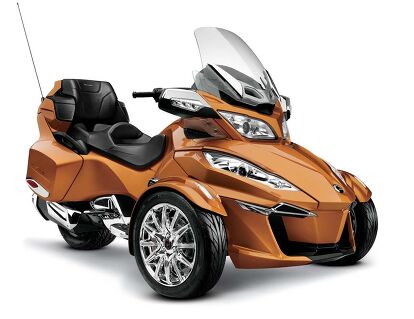















































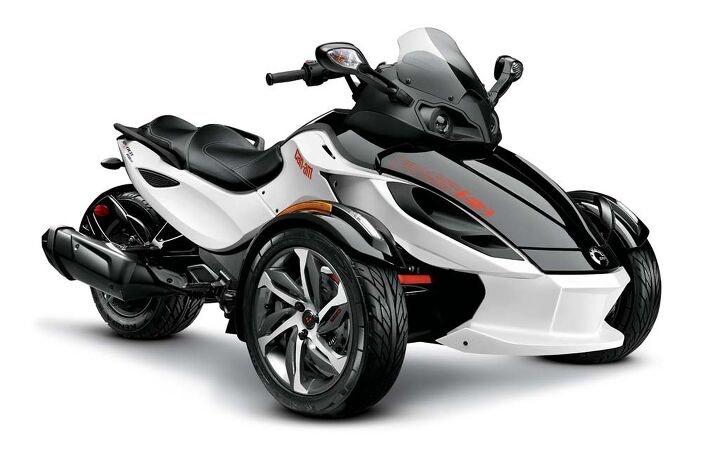







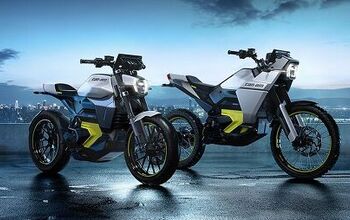






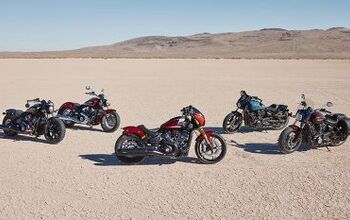

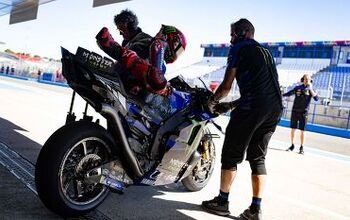



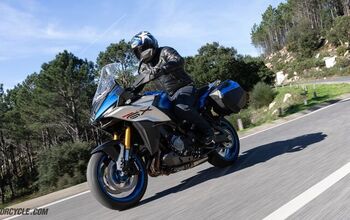



Comments
Join the conversation
I have no intention of ever having a passenger on one of these so my primary concerns are cargo, driver comforts (backrest) etc. I am pretty new to bikes so I don't understand why there is no seat design like that for somebody like myself who has those concerns.
Found this site while doing research for all forms of a new vehicle, looks good so far.
I have 2013 ST Ltd front end dives and want to upgrade the front shocks to something providing flatter cornering. I have upgraded the sway bar. I'm thinking something from the 2014 line up. Either RS Sachs or Fox adjustable. Any ideas?